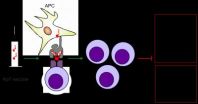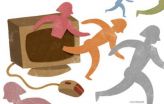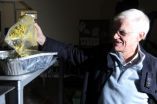(Press-News.org) The performance of a brain-machine interface designed to help paralyzed subjects move objects with their thoughts is improved with the addition of a robotic arm providing sensory feedback, a new study from the University of Chicago finds.
Devices that translate brain activity into the movement of a computer cursor or an external robotic arm have already proven successful in humans. But in these early systems, vision was the only tool a subject could use to help control the motion.
Adding a robot arm that provided kinesthetic information about movement and position in space improved the performance of monkeys using a brain-machine interface in a study published today in The Journal of Neuroscience. Incorporating this sense may improve the design of "wearable robots" to help patients with spinal cord injuries, researchers said.
"A lot of patients that are motor-disabled might have partial sensory feedback," said Nicholas Hatsopoulos, PhD, Associate Professor and Chair of Computational Neuroscience at the University of Chicago. "That got us thinking that maybe we could use this natural form of feedback with wearable robots to provide that kind of feedback."
In the experiments, monkeys controlled a cursor without actively moving their arm via a device that translated activity in the primary motor cortex of their brain into cursor motion. While wearing a sleeve-like robotic exoskeleton that moved their arm in tandem with the cursor, the monkey's control of the cursor improved, hitting targets faster and via straighter paths than without the exoskeleton.
"We saw a 40 percent improvement in cursor control when the robotic exoskeleton passively moved the monkeys' arm," Hatsopoulos said. "This could be quite significant for daily activities being performed by a paralyzed patient that was equipped with such a system."
When a person moves their arm or hand, they use sensory feedback called proprioception to control that motion. For example, if one reaches out to grab a coffee mug, sensory neurons in the arm and hand send information back to the brain about where one's limbs are positioned and moving. Proprioception tells a person where their arm is positioned, even if their eyes are closed.
But in patients with conditions where sensory neurons die out, executing basic motor tasks such as buttoning a shirt or even walking becomes exceptionally difficult. Paraplegic subjects in the early clinical trials of brain-machine interfaces faced similar difficulty in attempting to move a computer cursor or robot arm using only visual cues. Those troubles helped researchers realize the importance of proprioception feedback, Hatsopoulos said.
"In the early days when we were doing this, we didn't even consider sensory feedback as an important component of the system," Hatsopoulos said. "We really thought it was just one-way: signals were coming from the brain, and then out to control the limb. It's only more recently that the community has really realized that there is this loop with feedback coming back."
Reflecting this loop, the researchers on the new study also observed changes in the brain activity recorded from the monkeys when sensory feedback was added to the set-up. With proprioception feedback, the information in the cell firing patterns of the primary motor cortex contained more information than in trials with only visual feedback, Hatsopoulos said, reflecting an improved signal-to-noise ratio.
The improvement seen from adding proprioception feedback may inform the next generation of brain-machine interface devices, Hatsopoulos said. Already, scientists are developing different types of "wearable robots" to augment a person's natural abilities. Combining a decoder of cortical activity with a robotic exoskeleton for the arm or hand can serve a dual purpose: allowing a paralyzed subject to move the limb, while also providing sensory feedback.
To benefit from this solution, a paralyzed patient must have retained some residual sensory information from the limbs despite the loss of motor function – a common occurrence, Hatsopoulos said, particularly in patients with ALS, locked-in syndrome, or incomplete spinal cord injury. For patients without both motor and sensory function, direct stimulation of sensory cortex may be able to simulate the sensation of limb movement. Further research in that direction is currently underway, Hatsopoulos said.
"I think all the components are there; there's nothing here that's holding us back conceptually," Hatsopoulos said. "I think using these wearable robots and controlling them with the brain is, in my opinion, probably the most promising approach to take in helping paralyzed individuals regain the ability to move."
###
The paper, "Incorporating feedback from multiple sensory modalities enhances brain-machine interface control," appears in the Dec. 15 issue of The Journal of Neuroscience. Authors on the paper are Aaron J. Suminski, Dennis C. Tkach, and Hatsopoulos of the University of Chicago, and Andrew H. Fagg of the University of Oklahoma.
Funding for the research was provided by the National Institute of Neurological Disorders and Stroke and the Paralyzed Veterans of America Research Foundation.
END
Washington, D.C. (December 14, 2010) -- While the causes of epileptic seizures continue to confound brain researchers, scientists have been exploring how changes in the coordinated activity of brain networks, as monitored through electrodes, might help predict impending seizures. A report in the American Institute of Physics' journal CHAOS offers new insight into this possibility.
Two properties are commonly used to measure fluctuations in the activity of a brain network; one, known as L, relates to the overall connectedness between the activities of brain regions (or ...
In an exciting example of international collaboration, a Qatar astronomer teamed with scientists at the Harvard-Smithsonian Center for Astrophysics (CfA) and other institutions to discover a new alien world. This "hot Jupiter," now named Qatar-1b, adds to the growing list of alien planets orbiting distant stars. Its discovery demonstrates the power of science to cross political boundaries and increase ties between nations.
"The discovery of Qatar-1b is a great achievement - one that further demonstrates Qatar's commitment to becoming a leader in innovative science and ...
JAMBI, Indonesia – A Sumatran rainforest named a global priority for tigers and home to a unique orangutan rescue project is targeted for clearcutting by one of the world's largest paper suppliers.
An investigation found that since 2004, companies affiliated with Asia Pulp & Paper/Sinar Mas Group have sought out selective logging concessions with dense natural forests in the Bukit Tigapuluh landscape. The companies obtained government licenses to switch the forest status to industrial timber plantation concessions, sometimes under legally questionable circumstances. ...
TUCSON, Ariz. (Dec. 14, 2010) -- A unique underground surveillance system tested by UA researchers could be used to watch the entire U.S.-Mexico border continuously.
The border-monitoring system, known as Helios, consists of laser pulses transmitted through fiber-optic cables buried in the ground that respond to movements on the surface above. A detector at one or both ends of the cable analyzes these responses. Helios is sensitive enough to detect a dog and can discriminate between people, horses and trucks. The system can be set to avoid being triggered by small animals, ...
YOUR BODY'S OWN VACCINE: Researchers at BRIC, the University of Copenhagen, have discovered for the first time a protein normally found in the body that can act to prevent chronic tissue inflammation. When administered in the form of a therapeutic vaccine it is able to effectively prevent and treat a number of different inflammatory disease models for multiple sclerosis (MS), rheumatoid arthritis (RA), skin hypersensitivity and allergic asthma (AA).
The article, entitled, "Endogenous collagen peptide activation of CD1d-restricted NKT cells ameliorates multiple tissue-specific ...
High-speed trains consume 29% less energy than conventional trains per passenger transported, and reduce CO2 emissions by the same proportion. These are the conclusions of a study by the Spanish Railways Foundation published in the journal Transportation Research Record.
"A high speed train operating in normal conditions consumes less energy and produces less CO2 emissions per passenger transported (on average 29% less) than a conventional train travelling between the same two points at a lower speed", Alberto García, author of the study and a researcher at the Spanish ...
Scientists investigating the allergic reactions that asthmatics suffer towards a common mould have discovered that many people with asthma actually had the mould growing in their own lungs.
The research led by University of Leicester scientists at Glenfield Hospital has been published in the December 2010 issue of the American Journal of Respiratory and Critical Care Medicine.
The team based in the Institute for Lung Health at the University of Leicester and Glenfield Hospital examined the impact on asthmatics of a common environmental mould, Aspergillus fumigates, ...
University of Manchester scientists have discovered for the first time an important new way in which the human papilloma virus (HPV) triggers cancer in what could lead to new treatments for cervical and mouth cancer.
HPV infection is known to increase the risk of developing cancers of the cervix and mouth with the two high-risk forms of the virus accounting for approximately 70% of all cervical cancer cases.
Vaccinations against these high-risk forms of HPV should reduce the incidence of cervical cancer but the frequency of mouth cancer actually increased in the UK ...
Cyber bullying is an emerging phenomenon that is becoming increasingly common among teenagers. Research by the University of Valencia (UV), based on a study carried out in the region, shows that between 25% and 29% of all teenagers have been bullied via their mobile phone or the internet over the past year.
"The data from our study shows that technological bullying affects 24.6% of teenagers in the case of mobile telephony, and 29% with regard to the internet. In the large majority of cases, this abuse lasts for a month or less", Sofía Buelga, co-author of the study and ...
On average we each consume 120 grammes of plastic wrapping on Christmas gifts most of which is of a type which is almost impossible to recycle. Now researchers at the University of Warwick have devised a new technique which could process 100% of Christmas and other household plastic instead of the tiny fraction that currently actually gets processed - typically only 12% of such waste is truly recycled often the rest is often put into land fill or simply burnt as fuel.
Some plastic still goes straight to land fill but householders currently spend a great deal of effort ...




